
Why I study Snow:
Snow cover helps to regulate the temperature of the Earth's surface. So changes in snow cover has a direct impact on the exchange of heat between Earth's surface and the atmosphere, or the Earth's energy balance. I study snow in order to track climate change.
Snow sensitivity to feedback processes such as snow-albedo feedback is unique. As surface air temperature increases, snow cover shrinks; reveals a land surface that is much less reflective, and absorbs more solar radiation, which further enhances the initial warming by solar radiation. On the other hand, the remaining snow undergoes metamorphosis which results in a lower albedo. The direction and amplitude of current climatic trends especially in the polar regions depends on this snow-albedo feedback process, which we don’t quite understand.
Declining seasonal snow has more serious consequences especially where the alpine winter snowfall plays a crucial role in supplying water to streams, rivers and reservoirs – on which millions depend for their water supply. The snowpacks form one of the biggest reservoir in our water supply by locking up water over winter and releasing it slowly over spring and into summer, evens out the flow that feeds streams and rivers during the dry seasons. If the same amount of water fell as rain in winter, it would quickly cause reservoirs to overflow, with the excess flowing straight to the sea
A changing climate could alter forests, crop yields, and water supplies, hence, affect people.
How I study Snow:
To study snow, I make observations with an airborne instrument known as Cloud Absorption Radiometer (CAR - https://car.gsfc.nasa.gov ). The instrument is famous for its measurements of the bidirectional reflectance-distribution function (BRDF). An accurate retrieval of snow albedo from satellite data requires accurate measurements of the snow BRDF. Satellite sensors measure the reflected radiation into a few wavelength bands and particular directions. These measurements must be converted to albedo for radiation budget calculation using a suitable BRDF model.
Although, remote-sensing techniques offer exciting possibilities for monitoring the changes in snow properties with time and at all spatial scales, forests canopy has a huge impact on the observed signal. The aim of my project is to improve our understanding of the effect of forest canopy on remote sensing observations of snow-covered terrain. I investigate the impact of vegetation in the retrieval of snow parameters from the optical measurements.
The presence of vegetation has a significant impact on the propagation of the reflected signal, depending on vegetation structure, biomass, water content and snow cover fraction. Vegetation hides the signal from snow and, consequently, compromises the sensitivity to snow parameters. Due to the lack of good data, radiative transfer model for snow-covered vegetated terrain lacks a capacity for consolidating the relationship between vegetation type/age and vegetation parameters (e.g. the shape and dimensions of trunks and branches, etc.) among different cover types. Therefore, these processes are poorly represented in current climate models.
Selected Snow Publications:
1. Gatebe, C. K. and M. D. King (2016). Airborne spectral BRDF of various surface types (ocean, vegetation, snow, desert, wetlands, cloud decks, smoke layers) for remote sensing applications, In: Remote Sensing of Environment, 179, 131-148. DOI: 10.1016/j.rse.2016.03.029.
2. Lyapustin, A., C. K. Gatebe, R. Kahn, R. Brandt, J. Redemann, P. Russell, M. D. King, C. A. Pedersen, S. Gerland, R. Poudyal, A. Marshak, Y. Wang, C. Schaaf, D. Hall, and A. Kokhanovsky (2010). Analysis of snow bidirectional reflectance from ARCTAS spring-2008 campaign. In: Atmos. Chem. Phys., 10, 4359–4375. DOI: 10.5194/acp-10-4359-2010.
3. Grab, S. W., C. K. Gatebe and A. M. Kinyua (2004).Ground Thermal Profiles from Mount Kenya, East Africa. Geografiska Anna (Series A), 86 (2), 131-141. DOI: 10.1111/j.0435-3676.2004.00219.x.

